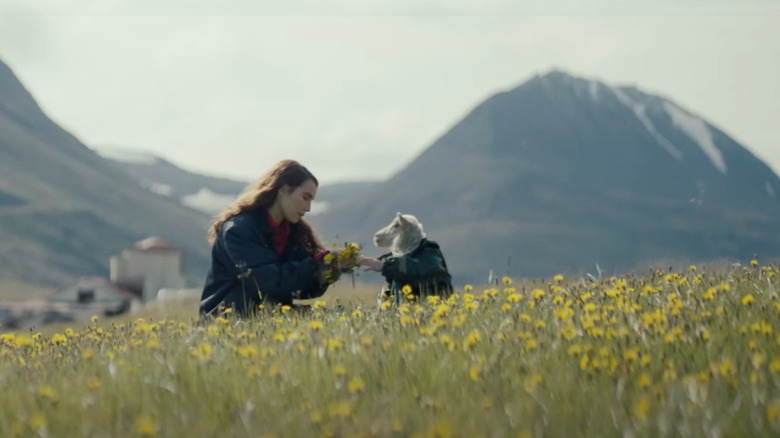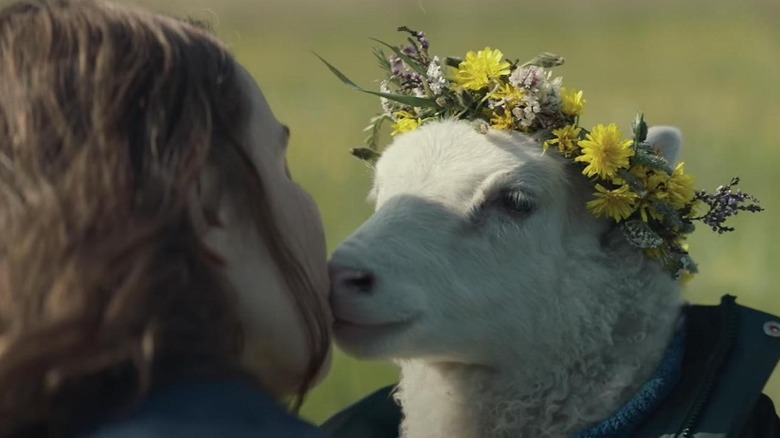Lamb Review: Noomi Rapace Shepherds A Gentle Folk Horror Film
There's a certain expectation that comes with an A24 horror film. Haunting. Creepy. Eerie. Unsettling. But while these words can be used to describe the latest A24 horror outing, "Lamb," none of them wholly encompass this strangely gentle Icelandic folk tale about motherhood. Directed and co-written by Valdimar Jóhannsson, "Lamb" is as curious a creature as the weird hybrid lamb at the center of its story, like a fantastical tale dreamed up by Jóhannsson in the odd hours of the morning.
"Lamb" unfolds quietly and slowly, following Maria (a superb Noomi Rapace) and her husband Ingvar (Hilmir Snær Guðnason) as they peacefully go about life in their remote Icelandic farm. They barely speak for the first half hour of the film, but they don't need to — their lives are filled with the sounds of that farm: the braying of the sheep, the fuzzy music of the radio station that they play for their animals, the rumble of their old, wheezing tractor. Maria and Ingvar wordlessly perform both the mundane and more bloody chores — feeding hay to their sheep, helping their pregnant livestock give birth. Even in their cozy little house, little more is heard other than the clacking of their silverware. It's a borderline ASMR experience (which would be soothing apart from the surprisingly gruesome depictions of live animal births), until Ingvar happily remarks to Maria that he doesn't want anything to change. Maria only offers him a pained smile in return, giving the faintest hint of a suggest that perhaps she's not as content in this peaceful life as he is.
But change does come for this isolated couple, and it comes in the most unexpected and weirdest way. While guiding one of their sheep through a live birth, Maria and Ingvar are stunned to see the baby lamb that has landed in their laps. Immediately, Maria cradles the lamb, obscuring it from the camera while the couple take it into their house and leave the mother in the sheep shed. Jóhannsson intentionally blocks our view of this baby lamb for a decent amount of time, leaving only the head visible while Maria and Ingvar busy themselves getting the house ready for a new baby — Ingvar dusting off an old crib in their garage, Maria constantly crooning over what appears to be an ordinary animal. But a creeping dread starts to enter the film, as something doesn't seem quite right with the whole picture. Maria and Ingvar are over the moon for this animal that they treat like a human infant, and sometimes, in the corner of the frame at night, we see something with strange limbs scurry through the house. And the sheep, with their black, lightless eyes staring through the foggy Icelandic landscape, are restless.
A Dark Fairy Tale
It doesn't take long for the suspicion to sink in: this lamb isn't what it seems. Of course, it doesn't make the revelation any less bewildering (and frankly, kind of funny) to witness: the blankets that have frequently swaddled the lamb are peeled back to reveal a creature with a lamb head and a human body, with the exception of one hoof-hand. The attention that Maria and Ingvar have lavished on the lamb is finally made clear, though it doesn't make their immediate adoration of the lamb any less discomfiting. But while "Lamb" never loses its gentle tone even with the introduction of this uncanny hybrid creature, it does inject a new off-kilter energy that makes the film feel like it's dancing on the knife's edge.
What is the creature? Where did it come from? Why did it appear like this? Questions that inevitably plague the audience's mind are completely ignored by the happy couple, creating a dissonance that lends to the film's eerie vibe, even if it never loses its tenderness. The darkness of the story dances on the fringes of this Maria and Ingvar's happy little paradise — much like those fairy tales of old. Many might forget that those fairy tales doubled as cautionary tales warning children not to venture too far out of the light and into the dark, as deep and lovely as it might seem. But in this Icelandic summer, where the sun never sets apart from a few hours a day, it's hard to tell where the dark resides.
And like many a fairy tale, a childless couple that finally gets the child they've long yearned for must be tested in some way. This test comes in the form of Ingvar's malcontent brother Pétur (Björn Hlynur Haraldsson), who arrives late in the film as the audience surrogate: the only one to question what the hell this lamb-human hybrid is. But even he is eventually won over by the strange magic of the creature and of this isolated world that Maria and Ingvar have made for themselves.
"Lamb" is a sunny folk horror film that balances a sense of eerie dread with a gentleness that feels at odds with its "horror" label. But even while it uses the camera and tonal tricks of a horror film, I hesitate to call it an outright horror, at least in the contemporary sense. Rather, it's a dark fairy tale — not the kind that has been sanitized by Disney or even Hans Christian Anderson — but the kind that has been whispered to children by candelight for hundreds of years. It's a film better left unexplained, leaving far more of an impact in its unexplained mysteries than in its slim story.
/Film Rating: 7 out of 10

